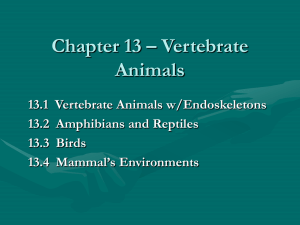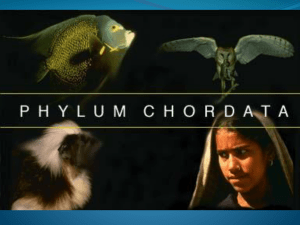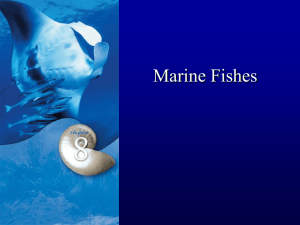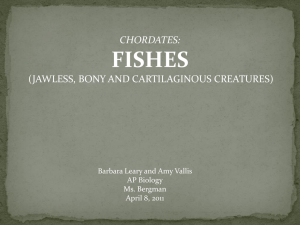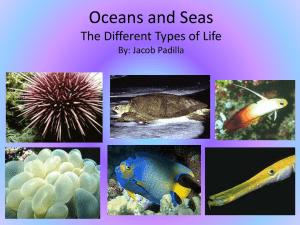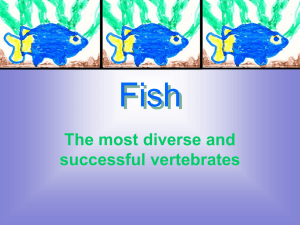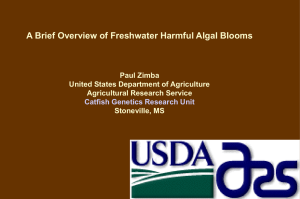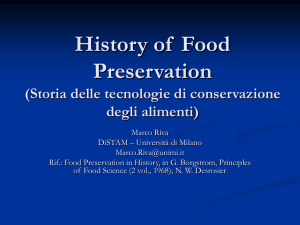Fish - Marblehead High School
advertisement
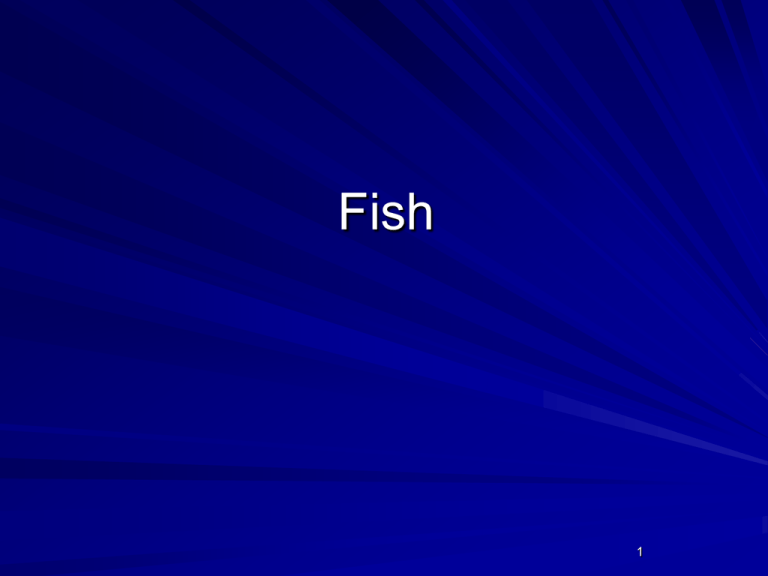
Fish 1 Trends Total fish consumption was 11.7 lb per person in 1970 and is 16 lb per person in 2005. Of the 16.3 lb, about 11.5 lb is fresh and frozen fish and about 4.3 lb is canned mainly tuna and salmon 2 Vertebrate - fish with fins Lean: <5% fat in edible flesh • Examples: cod, flounder, bluefish, sole, haddock, pike, perch Fatty or not lean: >5% fat in edible flesh Examples: eel, trout, salmon, shad, mackerel, lake bass, sturgeon 3 Shellfish or Invertebrates Mollusks - partially or wholly enclosed in hard shell Examples: oysters, clams, abalone, scallops, mussels Crustaceans - covered with crust-like shell and segmented bodies Examples: lobster, crab, shrimp, crayfish 4 Composition Similar to lean meat 18-20% high quality protein Low in fat and cholesterol Fat is most unsaturated 30-45% omega-3 fatty acids with 8-12% being eicosapentanoic acid (EPA) Fish are good sources of zinc, iron, and copper with marine fish being a good source of iodine 5 All shellfish contain glycogen - a polysaccharide used for CHO storage in liver and muscles. In some fish such as clams, oysters, and scallops, the sweet taste comes from the glucose formed by the enzymatic action from glycogen. Fish protein (dried) is a good source of proteins and is used in many parts of the world in breads, cereals, and crackers 6 Shellfish Should be purchased alive and/or lightly closed Shrimp - designated according to number required to weigh a pound. Jumbo, large, large-medium, medium, small. Oysters - purchased alive in shell, fresh, frozen, shucked or canned Lobsters - Northern (North Atlantic Ocean and Europe). Spiny or rock lobster absence of heavy front claws. Raw-blue green Cooked-red 7 Crabs - blue crabs come from the Atlantic and Gulf coasts and make up 3/4 of all marketed in U.S. Dungeness crabs are found on Pacific coast from Alaska to Mexico. Scallops - swim by snapping shells together. Adductor muscle is the only part eaten by Americans. Europeans known to eat entire scallop. Shellfish are easily toughened by high temperatures. Often simmered or steamed for short time. 8 Other Fish Products Roe - fish eggs, most can be consumed. Often parboiled and dipped in crumbs or cornmeal and fried. Caviar - sturgeon roe preserved in brine Surimi - made from a process of mechanically deboning fish flesh to create fabricated fish foods. Examples: sea legs or “crab delight” 9 Finfish Fresh fish should have firm flesh, stiff body, tight scales. Gills are red, eyes are bright and unsunken. With pressure the body does not leave indentation in the flesh. Little or no slime on exterior and odor is fresh but characteristic Canned fish: salmon, tuna, sardines, shrimp, crab, lobsters, clams. Tuna most common: packed as fancy or solid pack, chunk style, or flaked or grated. 10 Inspection and Quality Voluntary and is done upon the request of processor Duties of National Marine Fisheries Service of the U.S. Department of Commerce Many states have additionally requirements Quality is based on appearance, uniformity, absence of defects, character (texture), flavor, and odor 11 Storage Fresh fish is highly perishable. Must be frozen or stored in ice until sold. As bacteria decompose fish, a substance called trimethylamine is released. Trimethylamine is measured to assess the bacteria counts in fish Rapid spoilage also due to high enzyme activity in fish Store below refrigerator temperatures (30 F) for only 1-2 days and covered tightly to prevent contamination of other foods. 12 Market Forms Drawn fish - entrails removed Dressed - scaled, eviscerated, heads, tails, fins removed Steaks - cross section of dressed fish Fillets - side cut off fish lengthwise away from back bones Butterfly fillet - both sides of fillet Fish sticks - cut from fillets or steaks or made from minced fish 13 Cooking Finfish Both dry and moist heat methods are used, although due to delicate structure of tissues and low amounts of connective tissue, dry methods are common. Fish should be fully cooked to avoid sources of parasites and bacteria. Fish is fully cooked when flakes of flesh separate easily Overcooking is often considered undesirable due to dryness 14 Common Cooking Methods Frying - fillets and whole fish Broiling - steaks and fillets Baking - fillets, stuffed, or whole fish Steam Microwave 15



